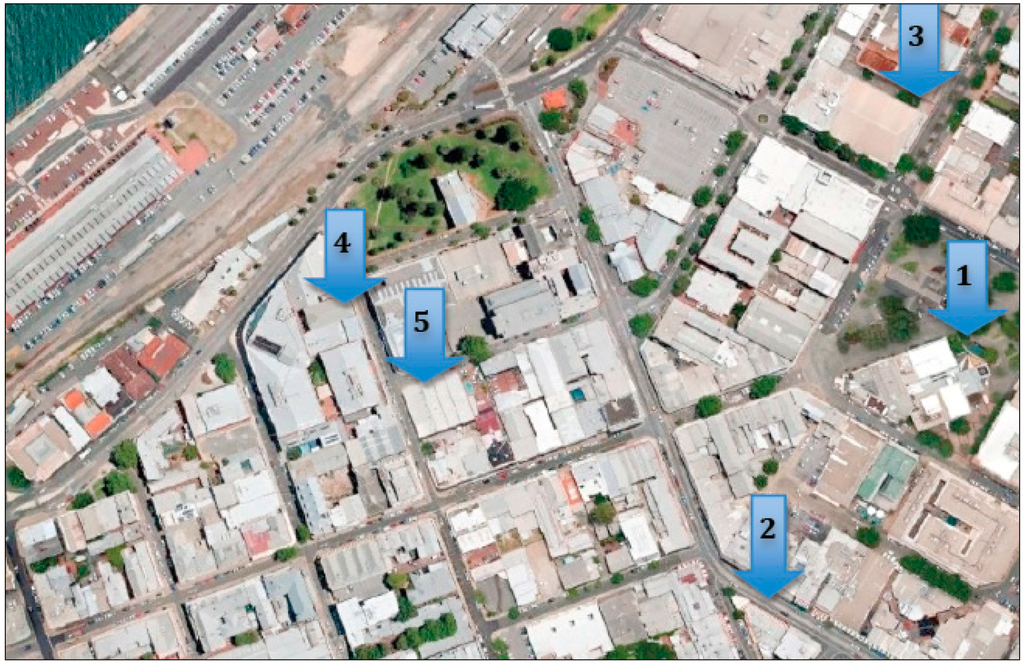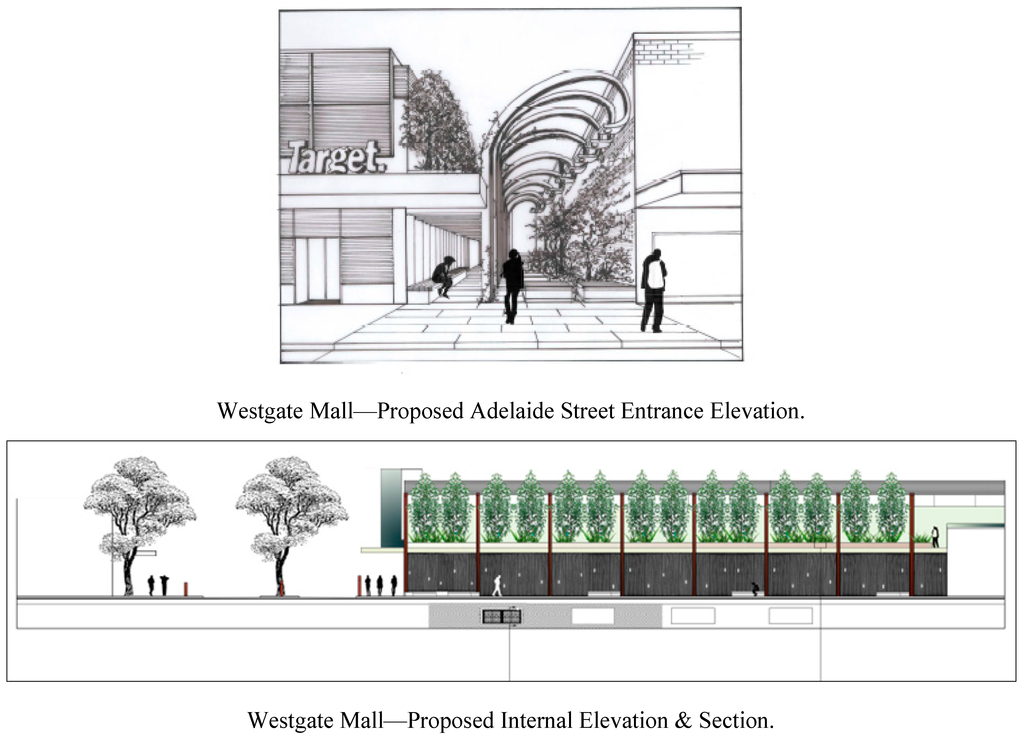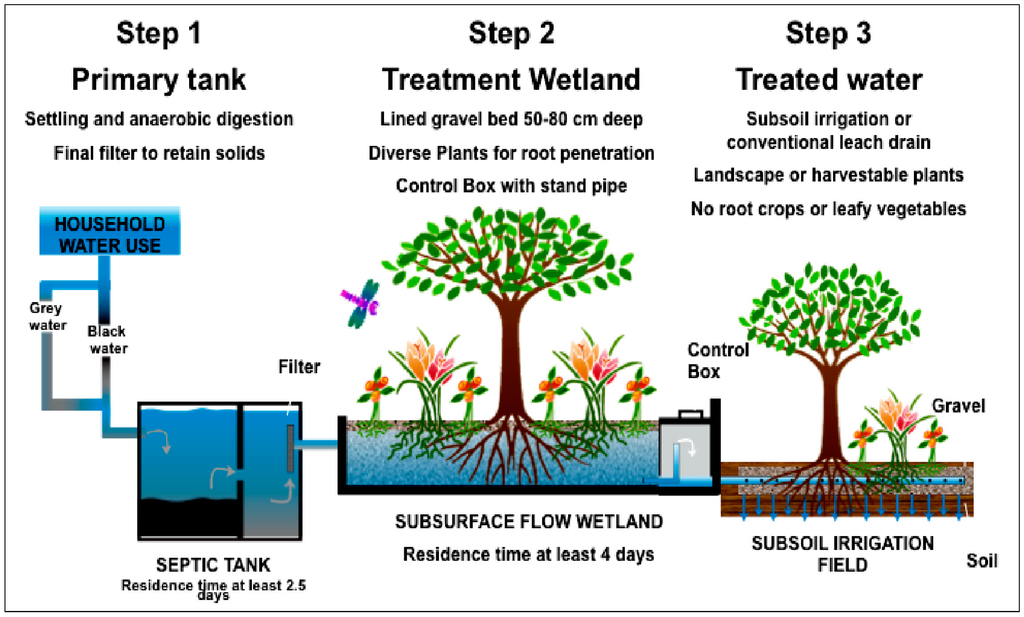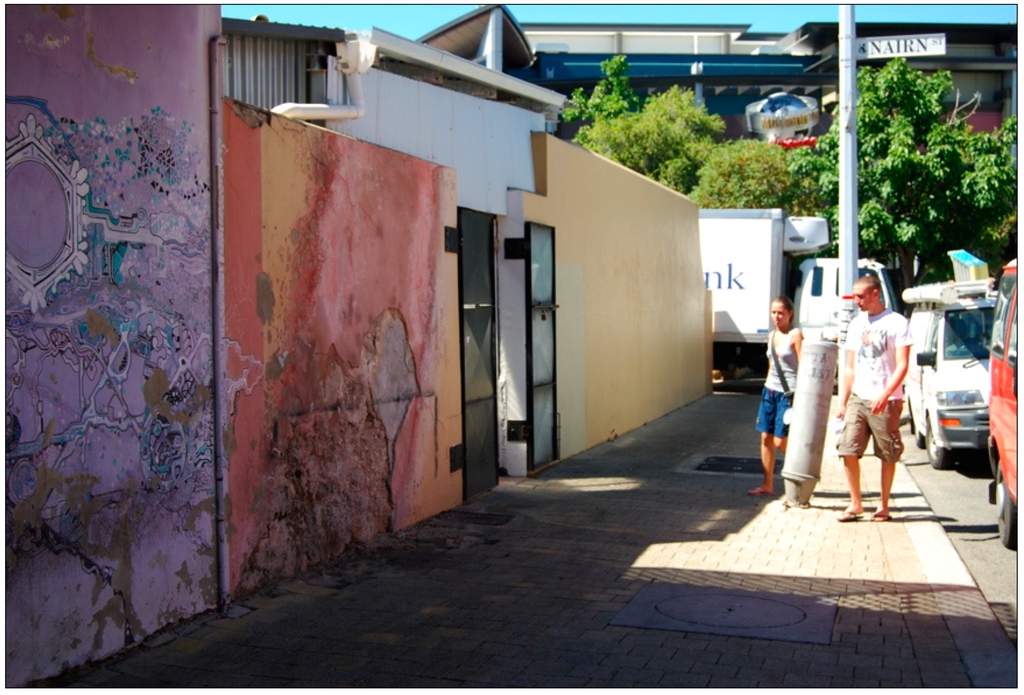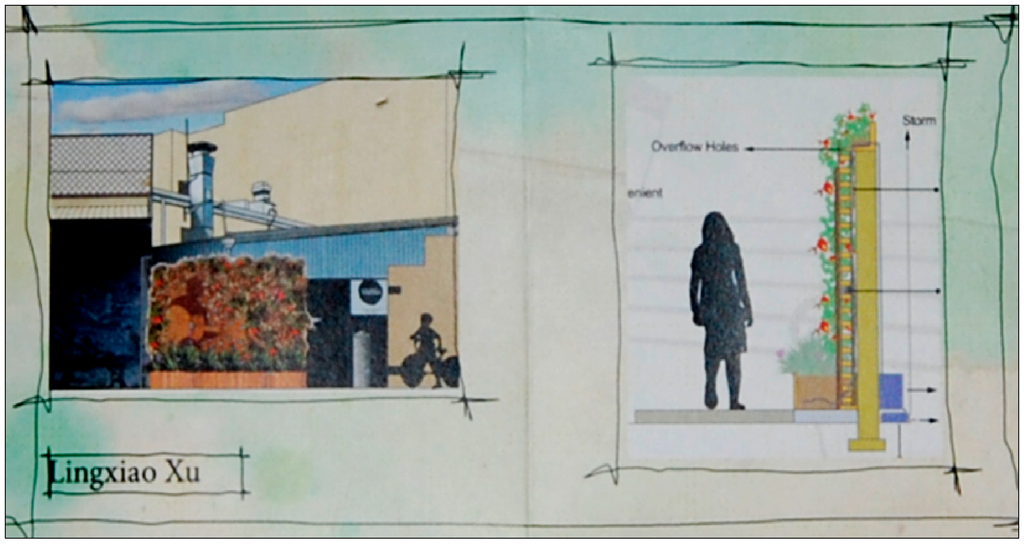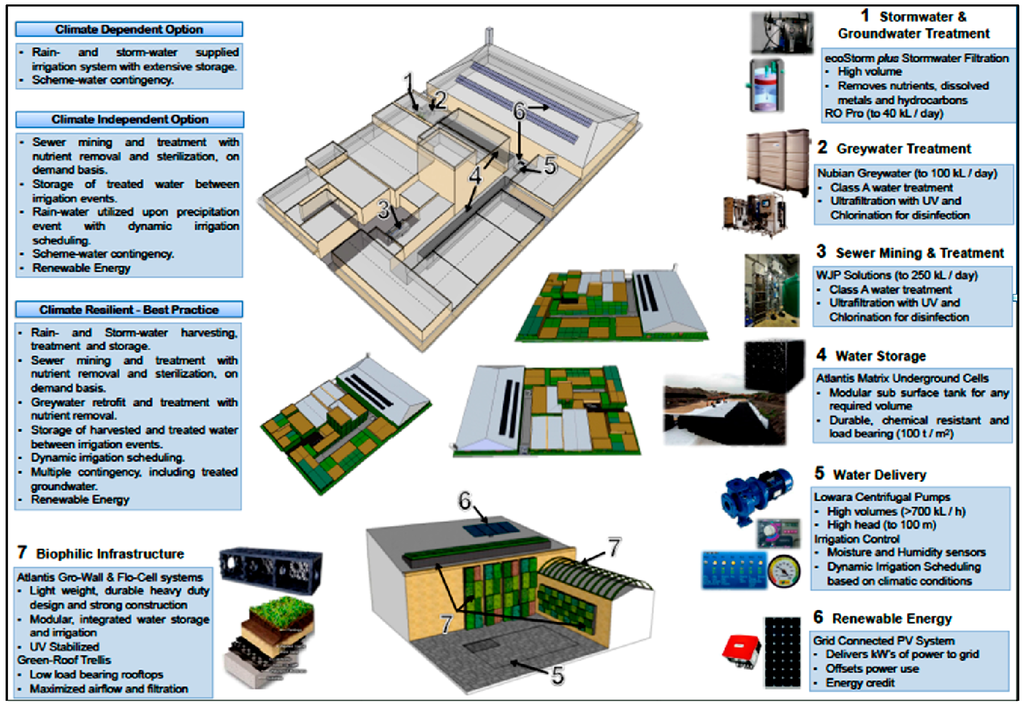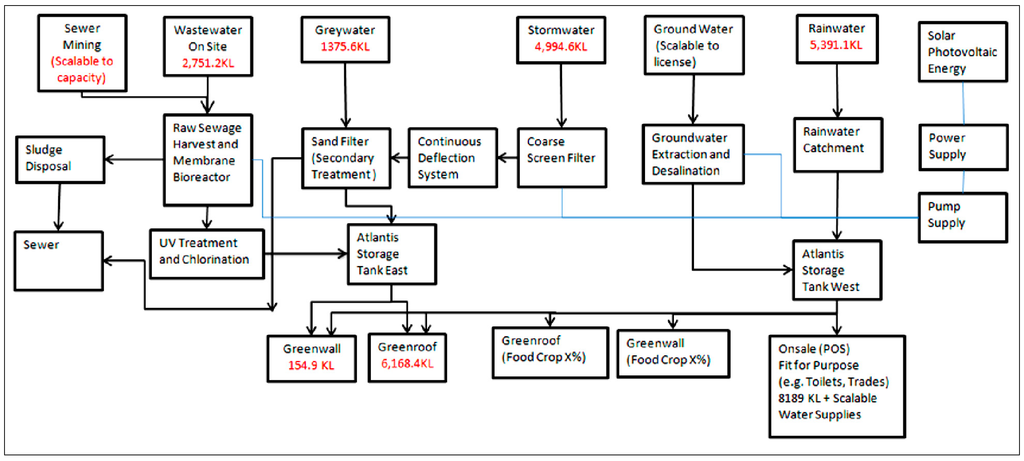Sustainable Urban Biophilia
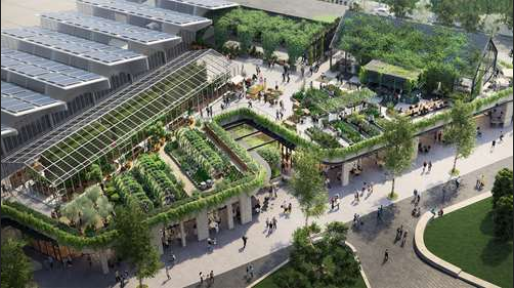
Green infrastructure ameliorates the urban heat island effect, contributes positively to liveability and enables sustainability in higher density urban environments. Greenskins (living architectures) are a more specific form of green infrastructure, including green walls and green roofs, for dense urban areas. These offer a new approach for sustainable urban biophilia and some forms can be built using the ecological design principles of constructed wetlands. The paper compares findings from two urban centres in warm Mediterranean climates. In general from Adelaide, South Australia and more specifically from university collaborative projects on particular technical and social parameters necessary to sustain Greenskins in dense urban conditions in Fremantle, Western Australia. Results from trials of a prototype greywater Greenskin using vertical constructed wetland cells are reported. Through an experimental investigation of designing living green walls in urban Fremantle, this paper challenges the conventional “triple-bottom-line” approach to sustainable dense urban systems by addressing the greater aesthetic needs of sustainability and its thinking. Here landscape aesthetics looks to the collaborative fields of urban design, environmental engineering and landscape architecture to design new urban biophilic experiences and restorative landscapes for regenerative cultural pleasure, ecological responsibility, environmental stewardship and intellectual gain.
Keywords:
green walls; green roofs; urban density; constructed wetlands; design principles; urban biophilia1. Introduction
Biophilic cities and their urban manifestations are dominating environmental planning and design discourses of the modern era. The specific metabolic natures of cities are changing and the traditional greening of urban fabrics are now transforming into new architectures and landscapes around the globe. Greenskins or living walls for buildings and their landscapes in urban areas are a new approach to green infrastructure for sustainable urban biophilia and some forms can be built using the ecological design principles of constructed wetlands. Greenskins reduce the urban heat island effect in cities by planting of vegetation on a large scale so that the effects of evapotranspiration, insulation and increased reflection of incoming solar radiation will cool a community a few degrees in the summer. Greenskins improve public health by adding to livability in numerous ways. Sustainability in higher density urban environments is enhanced by improved thermal performance directly by individual buildings, indirectly across cities, thereby reducing energy demand and consequently reduced greenhouse gas emissions.
The broad aim of the research outlined in this paper was to develop and trial some green infrastructure principles and parameters through a number of key design proto-type projects in Fremantle, Western Australia. Four specific and inter-related research objectives were defined around the sustainable development of these Greenskin Infrastructure projects:
Investigate the necessary technical and socio-design parameters that apply to sustaining Greenskin Infrastructures into existing urban forms;
Identify the sustainable design opportunities and constraints of adapting constructed wetland cells as vertical Greenskin Infrastructures for their water use and associated hydraulic functions;
- (1)
-
Identify potential design opportunities in enabling Greenskin Infrastructures to function as bio-diverse systems and to contribute to the bio-diversity requirements of their urban environments; and
- (2)
-
Challenge the conventional “triple-bottom-line” approach to sustainable systems by addressing the greater aesthetic needs of designed Greenskin environments, especially in the ways that they can contribute to the sensorial vitality and liveability of specific urban and culturally charged settings.
2. Background
Urbanists and city planners have special opportunities and unique obligations to advance biophilic city design, utilizing a variety of strategies and tools, applied on a number of geographical and governmental scales. The agenda is one that must extend beyond conventional urban parks, and beyond building-centric green design. It is about redefining the very essence of cities as places of wild and restorative nature, from rooftops to roadways to riverfronts, local and regional parks and open space systems. It is about understanding cities as places that already harbor much nature and places that can become, through bold vision and persistent practice, even greener and richer in the nature they contain [1].
The first and most obvious of the biophilic design elements is the environmental features they embody, involving the use of relatively well-recognised characteristics of the natural world in the built environment.
Water is among the most basic human needs and commonly elicits a strong response in people. John Ruskin remarked “… without a single exception, every Homeric landscape, intended to be beautiful, is composed of a fountain, a meadow, and a shady grove.” The effective use of water as a design feature is complex and contingent on such considerations as quality, quantity, movement, clarity, and other characteristics. After decades of being banished from residential areas, water is now becoming an increasingly significant feature in urban design. Whether it is the use of rainwater or the integration of natural water courses into the built environment, the incorporation of water elements in urban areas for climatic purposes, or the creation of oases of tranquility or drama such as pools or fountains—all these issues are not only encountering renewed interest among professionals, but they are also meeting with appreciation from the general public [2].
Green Infrastructure and building façade greening: Buildings with vegetative facades, such as ivy walls or green roofs, often provoke interest and satisfaction. This likely reflects historic benefits associated with organic materials as sources of insulation, camouflaging protection, or even food. Plants on buildings and constructed landscapes can also evoke a powerful vernacular, such as the thatched or vegetative roofs of many cultures [3].
Plants have found a home on walls for centuries, but are sometimes incongruous with architecture, often breaking down the structural integrity of a building’s facade. Patrick Blanc’s Vertical Garden System, known as Le Mur Vegetalin French, allows both plants and buildings to live in harmony with one another. The botanist cum vertical landscape designer is probably best known for his provocative living wall on the Musée du Quai Branly in Paris where form and function are brought together in exciting and innovative ways. But Blanc’s Vertical Garden System can be implemented anywhere: indoors or out and in any climatic environment. The three-part system consists of a PVC layer, felt, and metal frame, providing a soil-free self-supporting system light enough to be hung on the wall, and even suspended in the air, weighing in at less than 30 kilograms per square meter. The Vertical Garden can be used as an impressive outdoor system, or can be used indoors, with the help of artificial lighting. The natural benefits of the Vertical Garden are many: improved air quality, lower energy consumption, providing a natural shield between weather and inhabitants. No matter where you live, urban or suburban, cold or hot, indoors or out, the Vertical Garden brings a little bit of green to all [4].
Green infrastructure can be considered a conceptual framework for understanding the “valuable services nature provides the human environment”. At the national or regional level, interconnected networks of park systems and wildlife corridors preserve ecological function and create a balance between built and natural environments. At the urban level, parks and urban forestry are central to reducing energy usage costs and creating clean, temperate air. Lastly, green roofs, walls, and other techniques within or on buildings bring a range of benefits, including reduced energy consumption and dramatically decreased stormwater runoff. At all scales, green infrastructure provides real ecological, economic, and social benefits [5].
Green Infrastructure is the incorporation (integration) of both designed and natural vegetation and green spaces in our cities for its natural resource values and for its associated environmental and socio-economic benefits it provides to people living a built environment. Green Infrastructure includes remnant vegetation, urban agriculture, city street trees, green roofs and green walls (urban greening technologies), bio-filters/rain gardens (Water Sensitive Urban Design), parks, gardens and golf courses (green spaces) and vegetated urban design. It also embodies the sustainable building materials like recycled or reconstituted paving and wall features that are typical to urban design projects, for example. By incorporating the use of Green Infrastructure in our cities, we improve the built urban environment and provide ecosystem services. Urban Green infrastructure values can be measured in terms of people’s health and well-being, conservation and promotion of ecological balance, ecological footprinting, material embodied energy, greenhouse gas capture, local climate amelioration, reduction in energy use, food production and water retention (reduced storm water runoff) and improvement in water quality.
Over the next decades, as noted by McLain (2012), green infrastructure initiatives such as tree planting campaigns, and ecological restoration will dramatically change the species composition, species distribution and structure of urban forests across the likes of United States [6]. These impending changes are accompanied by a demand for urban public spaces where people can engage in practices such as gardening, food and livestock production. McLain’s work analyses the institutional framework that undergirds efforts in Seattle, Washington, for example, to normalize the production and use of edible landscapes. The work focuses its attention on the role of grassroots fruit cropping groups and highlights their bridging function between Seattle’s agriculture and forestry policy arenas, creating an entry point for re-conceptualizing urban forests as sites of production. They conclude that a vision of urban forests as providers of goods as well as services may provide a more solid foundation for achieving urban sustainability than the current “hands off” approach to urban forest management. Gardening and food foraging in urban wild and cultivated landscapes provides opportunities for inhabitants to steward public natural resources and interact deeply with nature.
The concept of Green Infrastructure can be considered to comprise of all natural, semi-natural and artificial networks of multifunctional ecological systems within, around and between urban areas, at all spatial scales [7]. Green Infrastructure emphasises the quality as well as quantity of urban and peri-urban green spaces, their multifunctional roles, and the importance of interconnections between habitats. If a Green Infrastructure is proactively planned, developed, and maintained it has the potential to guide urban development by providing a framework for economic growth and nature conservation. Such a planned approach would offer many opportunities for integration between urban development, nature conservation, recreation facility development and public health promotion [7].
Significant efforts have been undertaken in the warm Mediterranean climate of the city of Adelaide, South Australia to progress Greenskins. Hopkins (2010) demonstrated with specific green wall designs for Adelaide how these can reduce stress on the public health system in high density areas [8]. The biophysical benefit of visual and physical contact with nature through green infrastructure in hospitals and medical precincts can reduce stress, improve patient recovery rates and provide higher resistance to illness. Similarly, introducing green roofs and walls to office towers and commercial areas generally can increase worker productivity and reduce the number of sick days taken. Greenskins improve the local micro-climate by reducing the temperature and providing a pleasant environment or public space that encourages new economic opportunities such as cafes and outdoor eating.
Numerous researchers (McPherson, Herrington et al., 1988; Akbari, Pomerantz et al., 2001; Pokorny, 2001; Georgi and Zafiiridiadis, 2006) have shown how trees and other vegetation modify urban microclimates and help reduce the urban heat island effect through shading of urban surfaces from solar radiation, as well as cooling and humidifying from evapotranspiration [9,10,11,12].
Thus, these thermal effects of Greenskins help to reduce the “urban heat island” (UHI) problem. Plants have a cooling effect and therefore a combination of vegetation and lighter colour, using the albedo effect, have been shown to keep pavements, buildings and roofs cooler [13,14].
Green roofs and walls can be used to cool buildings through their insulation effect. Lehmann (2014) explained how to optimize this effect with the crucial parameters for green roofs being rooftop surface albedo, substrate depth, vegetation species, density of planting, watering regime/soil moisture and whether the roof is generally an extensive or intensive green roof. Lehmann argued that irrigation improves the performance of green roofs due to increased evapotranspiration, and the increased water use can be accommodated with recycling of greywater and rainwater harvesting [15].
Following Akbari et al. (2001) then Santamouris (2014) reviewed climatic change mitigation technologies aiming to increase the albedo of cities and finding the use of vegetative—green roofs presented a relatively high heat island mitigation potential [16]. Like Akbari et al. he found that on a city scale, green roofs may reduce the average ambient temperature between 0.3 and 3 K. Wang, (2014) found four main factors whereby urban green infrastructure influenced the indoor environment and the effects on human comfort and economic consequences, being vegetation characteristics, building characteristics (including layout and geometry), and geographical conditions. Wang found economic effects of adjoining vegetation and green roofs on climate regulation were energy savings of up to almost $250/tree/year [17].
Thus in Adelaide, for the success of its Green Infrastructure project, Pitman and Ely (2012) argued that planning and investment needed to be guided by the following five principles: integration, nature-based, collaboration, evidence, capacity [18].
In summary, it is clear that future biophilic cities will become net exporters of food, water, energy, waste, employment and civic pleasure. They will transform the very culture and nature of what we expect cities and urban centres to be. They will become biophysically specific to their environments and their communities. They will demand new localised intellects, technologies and practices that account for sustainable economic productivity as well as their enduring and regenerative aesthetic that makes urban living meaningful in social, spiritual and ecological terms. This dynamic integration of sustainable values and their technologies will provide the new benchmarks for defining liveable “green” cities and their ultimate sense of restorative place.
3. Methods
The Fremantle Greenskins project grew from like-minded discussions between Curtin University’s Sustainable Policy Institute (CUSP), Murdoch University’s Environmental Engineering program and The University of Western Australia’s Faculty of Architecture, Landscape and Visual Arts. The initial intentions were to organise a landscape architectural student project to consider the importance of living green walls and roof top gardens that could be applied to the central business district of The City of Fremantle. Five Fremantle sites were selected by the project research team and the initial project research was directed by a day-long seminar that included presentations by local and international experts experienced in biophilic urban design and construction, as well as local planning and heritage management issues relating to potential green infrastructure development specifically in Fremantle. The day culminated in a set of design briefs for the five chosen sites.
The five urban sites were selected to offer and range of challenges to design a Greenskin on each of the following buildings (see Figure 1):
- (1)
-
The Fremantle Library (eastern facade);
- (2)
-
Gino’s Cafe in South Terrace (northern facade);
- (3)
-
Westgate Mall off Adelaide Terrace;
- (4)
-
Curtin University’s Sustainable Policy Institute (CUSP) building in Pakenham Street;
- (5)
-
The PSARTS building in Pakenham Street.
The design issues related to:
- -
-
Urban context and streetscape sense-of-place relating to architectural and landscape character, building heritage policies, pedestrian and vehicular movement, and existing and potential use of the host building and surrounding streetscape. The proposed designs were required to enhance the private and public urban liveability of the particular host street or site confines. This could be gauged in terms of sustainable form and function with the design and use of colour, texture and patterns in the Greenskins, temperature modification or “air-conditioning” of the local site and its host building, and the conservation of recycled water for the growth of the Greenskin;
- -
-
Climate relating to local seasonal conditions of light exposure (aspect), temperature, rainfall, humidity, and prevailing wind conditions;
- -
-
Water use—local water supplies from town water, grey and black water treatment and recycling;
- -
-
Plant selection—the benefits of exotic or endemic plants relating to local character and aesthetic interests and benefits, water use, habitat provision, food production, disease control and overall maintenance requirements.
All in all, the respective Greenskin designs had to contend with a range of complex environmental, social, technological, aesthetic and economic considerations that were given even weight to their potential implementation. What became evident to the success of these designs was the way the project facilitated and coordinated the direct involvement of a range of disciplines and expertise interested in the designs of Greenskins. It was clear that the results of this project were to be borne in how these disciplines were to interact with each other in creative ways to achieve innovative, insightful and productive outcomes that would continue to challenge the integrated urban design fields of Greenskin development.
4. Results and Discussion
Not all design results of the Fremantle Greenskins Project will be reported here, but perhaps the most salient and successful results were achieved on the sites of the Westgate Mall and Gino’s Cafe.
4.1. Westgate Mall
Student Marika Parany led the charge on this design and cleverly addressed the difficulties of the site in terms of its lack of public amenity to the adjacent streetscape, poor selection and condition of materials (paving, planter boxes, seating, lighting, drainage) and how the Mall itself has become a “dead-end” or lost public space due to the course of nearby shop closures and poor maintenance. Parany’s proposed Greenskin includes the design of a suspended constructed wetland system that manages the rain and grey water discharge from the host Target building. This integrated system is designed in a way that provides for an inviting entry archway to the Mall with a system of vertical structures that provide for a range of sculptured planter boxes and plant climber habitats. The envisioned amenity “softens” the dominating salmon brick walls to provide for an exciting revitalised public “landscape room”. The design becomes a major piece of public art in its own context, providing for additional seating and feature lighting for safe day and night use and enjoyment. Parany compliments the Greenskin design with the support of additional street tree planting to the heavily built up thoroughfare and Mall entranceway from Adelaide Terrace (see Figure 2 and Figure 3). The constructed wetland detail of this design has been adapted from the design principles and work of Nelson, Hemsley and Anda, (2011), see Figure 4, [19].
Figure 4. Design schematic of a constructed Wastewater Garden wetland showing primary and secondary treatments and final subsoil irrigation treatments (after Nelson Hemsley and Anda, 2011).
4.2. Gino’s Cafe
Students Luke D’Annolfo and Lingxiao Xu designed their Greenskins at this location to capture site benefits of an exposed public streetscape that is utilitarian in character and typically known as the service access to the South Terrace businesses. The wall had previously been damaged by the explosion of a nearby gas main and remained in a poor state of repair. The site also enjoys full northern light and the easy access to scheme and grey water from the nearby toilet facilities of the Cafe and music venue of Kulcha. D’Annolfo chose to express his Greenskin design by playing on the social narratives associated with Fremantle’s rich history of cafes and in particular the Italian immigrant history of these cafe owners, workers and public alike. D’Annolfo designs the Greenskin wall as a coffee cup using metal super-structure and plant specimens to depict the outline and content of a typical Gino cup of coffee. He uses plant materials (rosemary, thyme, mint) that play on and provide fresh additional aromas to the streetscape. Xu identifies the site’s connection to the adjacent Kulcha music club and designs the Greenskin wall as a collection of musical instruments. Passersby’s get to hear the soft sounds of periodic music playing from within the guitar sculpture included in the Greenskin. This clever electronic design feature simply connects and amplifies the live music from within the club venue to the Greenskin wall outside (see Figure 5 and Figure 6). Interestingly, this design plays on the typical nature of Fremantle’s down-town urban spaces where the delights of hidden music are revealed and given a sense of publicness to the busy cosmopolitan streetscape.
The preliminary economic analysis of water-use for the proposed Greenskin designs has been undertaken and is outlined in Table 1. This analysis considers the design criteria of energy saving (kWh pa) versus the direct cost of mains potable water and recycled water (if the latter was available). From a sustainability perspective, the savings made from reduced energy consumption could be used to develop a business case for the implementation of a recycled water scheme. This would avoid the use of valuable, high quality, drinking water for irrigation.
Further studies of water use re-activation analysis were undertaken for three trial “swatches” of 1 square metre each and the Westgate Mall site by Murdoch University environmental engineering students and the results indicate the potential to expand this single Greenskin wall to the immediate context of the adjacent buildings in this block. Other walls, and water sources, in this neighbourhood could help develop a “community” of Greenskins that would work together collectively to enhance the urban biophilic benefits of this urban landscape. This study considered an integrated systems analysis approach in addressing the greater integrated and regenerative design goals of Greenskin development—namely by addressing the following seven analytical elements:
- -
-
Stormwater and Groundwater Treatment;
- -
-
Greywater Treatment;
- -
-
Sewer Mining and Treatment;
- -
-
Water Storage;
- -
-
Water Delivery (pumping to irrigation systems);
- -
-
Renewable Energy (for treatment plant and pumping);
- -
-
Biophilic Infrastructure.
The results of this study, outlined in Figure 7, showed how irrigation water could be supplied to all three configurations from all sources listed above with energy supplied from renewable energy systems. Water Balance modeling showed that, using the native plant selection and Elmich infrastructure:
-
A single 1 square metre swatch would require ~280 L/year, ~0.78 L/day on average, with a peak requirement of ~2 L/day on average through the hottest month of January.
-
The Westgate Mall would require ~61.5 kL/year, ~170 L of water per day on average, with a peak requirement of 382 L/day through January.
-
The Westgate Complex would require ~155 kL/year for green-wall infrastructure and ~6200 kL/year for green-roof infrastructure.
This water balance model is shown as a process flow diagram in Figure 8.
Figure 7. Westgate Mall Greenskins—a systems design options analysis and element integration approach (Murdoch University students).
Figure 8. Westgate Mall whole complex water balance model to support biophilic systems (Murdoch University students).
For the renewable energy system, a photovoltaic array was designed and sized in accordance to the treatment and pumping system requirements for electricity. It was found that 65 panels, each of 250 Watt peak capacity have been selected for a total of generated output of 16 kW.
Construction of the three trial “swatches” had commenced at the time of writing this paper and these would be monitored for performance of plant species, irrigation water consumption and contribution to the temperature modification and aesthetic liveability of their urban environs. Preliminary findings to-date show substantial plant survival and growth rates with a particular success with succulent plant species that are endemic to the Fremantle environs. The aesthetic pleasure and contributions to urban biodiversity offered by these Greenskins in their rather bleak urban settings will need further research, although it is fair to suggest that their lush plant form and profusion and diversity of plant colour has softened and provided extra aesthetic pleasure to their urban streetscapes. Moreover, the authors are particularly keen to investigate how the successful endemic plant use, for example, could offer greater habitat opportunities for local bird species, and whether associated insect and plant disease control benefits from these Greenskin features.
Construction of a green wall 3 m long × 3 m high at a nearby residential property was also completed at the time of writing the paper and trials had commenced with irrigation of domestic greywater. This green wall, shown in Figure 9, consisted of nine masonry planter boxes with a hydraulic and media set-up as vertical downward subsurface flow constructed wetlands through which the greywater was pumped.
Figure 9. Greywater greenwall prototype using vertical flow wetland configuration in planter boxes (photo and drawing by authors).
These nine planter box wetland cells each had internal dimensions of 360mm W × 860mm L × 360 mm H giving a planting area of 0.31 sqm or 2.8 sqm in total and a volume of 0.11 cum or 1.0cum in total. The average Perth household (based on three persons per house) produces approximately 120 L of greywater per person per day. Of this, 40 litres is produced in the laundry and 60 litres from the bathroom (ANZS 1547:2000). Obviously, this can vary enormously day to day. Greywater irrigation rates can be applied at between 5–10 mm/day (or 5–10 litres/sqm day) for gravels and sands (DoH, 2010) as is the case for substrates in constructed wetlands and which would also correspond to the peak evapotranspiration rate for plants in summer. Therefore as testing of this greenwall proceeds it can be expected that up to 28 litres per day of greywater could be injected from a public health land application perspective and some 40 m length of wall or fencing would be required for a household of three persons. From an effective treatment of point of view, before allowing the effluent from the greenwall to enter the natural environment, the wetland surface area required has been estimated to be 10–20 sqm per cum of effluent per day or about 2–5 sqm per person for total household wastewater (DLWC, 1998). Therefore, for greywater only to ensure effective treatment this method again estimates that the prototype can treat around 28 litres/day. Data collected from recent trials needs to be assessed to see if these estimates correlate well with actual results. Nevertheless, one can envisage new approaches to greenwall construction, such as depicted in this prototype with mass production to reduce costs, can be used in fencing and boundary walls for more pleasing aesthetic outcomes or along building walls for improving interior thermal performance.
5. Conclusions
The Fremantle Greenskins Project, along with the formation of a collective of local experts and commercial operators experienced in the construction and performance of living walls, initiated the installation of two Greenskin prototypes. This project partnership continues with the universities and The City of Fremantle through its technical service division and the support of horticultural and park development experts. Monitoring of these prototypes has already verified the importance of the broad design principles of green infrastructure in general that were identified as integrative, nature-based, collaborative, evidence-based and capacity-building. Trials on the prototypes have begun to reveal the importance of the technical design parameters necessary to sustain Greenskins specifically on urban forms including substrate depth, vegetation species and watering requirements. The greywater green wall was able to demonstrate the challenges of water recycling including the need to have effective filtration systems and soil substrates to avoid sediment accumulation and excessive nutrient runoff respectively.
Extending the learnings from the prototypes into Fremantle urban renewal design concepts, outlined in Figure 7, showed how irrigation water could be supplied with renewable energy systems.
Other studies proposed by the universities will address the potential greater strategic planning and design moves that the City of Fremantle could initiate to consider the benefits of Greenskins as ecological islands and interconnected wildlife corridors to address burgeoning conservation, biodiversity and potential climate adaptation requirements of the City. Here lies the greater urban biophilic benefits for green cities and their complimentary green infrastructures to include Greenskins in their essential makeup and performance.
The prototype developments resulting from the collaborative and integrated fields of environmental engineering and landscape architecture provided insights to the design of new biophilic experiences and restorative landscapes for regenerative cultural pleasure, sense of place and intellectual gain. In this light, biophilic aesthetics is considered the catalytic agent for the creative integration of five green infrastructural values—environmental, social, technological, aesthetic and economic—that typically escape sustainable planning and design projects in Western Australia. Accordingly, this paper identified a “Penta-Matrix Approach to Regenerative Development” (PEMARD) for all urban renewal projects to optimise sustainability outcomes. These are the stand out qualities of this integrated scientific and artful work.
In summary, this paper promotes the urban biophilic agendas of a progressive city like Fremantle—a city that has been developing ways of achieving social and environmental sustainability goals across a range of exciting social and physical urban planning and design platforms and related projects. Above all, this paper offers a greater debate and conversation of how the Greenskins Project as both a social and technological prototype and metaphor might embrace other complimentary green values, resources and technologies as regenerative measures that tackle the perceived limitations and often isolated paradigms of urban biophilia. It does this by explaining the virtues of integrated design as being the catalytic action towards regenerative biophilic thinking. This paper has shown how local and international experts have worked together to develop a growing and collective intellect and grass-roots practice for urban biophilic action through the integrated sciences, arts and design fields of environmental engineering and landscape architecture.
Finally, we look forward to the greater regenerative thinking and debate for a PEMARD or “Penta-Matrix Approach to Regenerative Development” in our biophilic cities, where projects exploit the creative integration of five core green infrastructural values—environmental, social, technological, aesthetic and economic—that typically escape the briefs and actualities of most sustainable planning and design projects in Western Australia.
Acknowledgments
The authors wish to especially acknowledge and thank fellow researchers in the Fremantle Greenskins Project, in particular Jana Soderlund, Peter Newman, Michael Leers and Ben Alpers, and the students from the University of Western Australia and Murdoch University for all their support and contribution to this paper.

